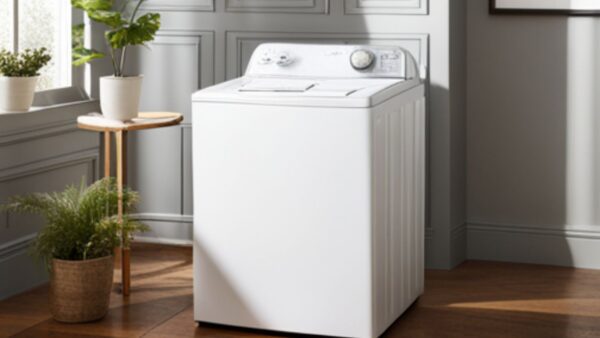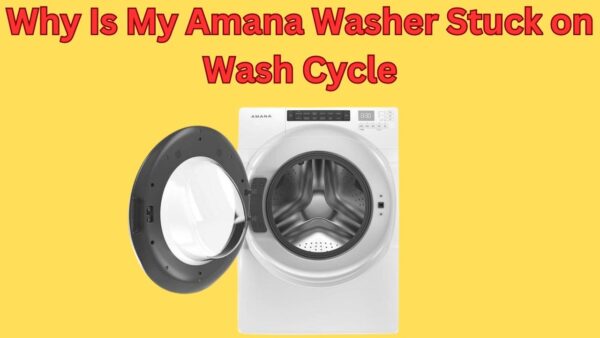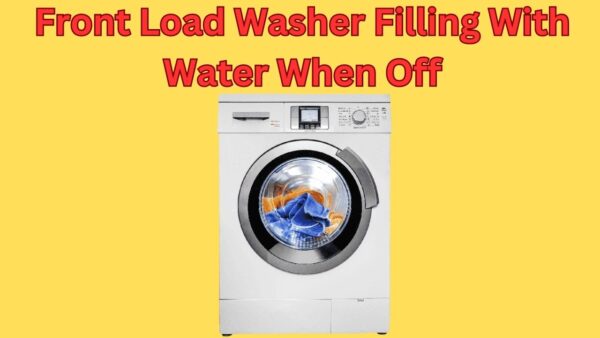When it comes to maintaining a clean, fresh wardrobe, your washing machine is your best ally.
However, proper drainage is vital to ensure this unsung hero of your household runs smoothly.
This guide will explore 15 common washing machine drainage options, helping you understand each one’s pros and cons.
Washing Machine Drainage Options (Let’s Know)

1. Direct Drainage Into a Laundry Sink
A very common and practical method of draining your washing machine is direct drainage into a laundry sink.
This method involves discharging the wastewater directly into a nearby laundry sink. It’s a simple and often convenient solution given the proximity of the washing machine to the sink in many homes.
However, it’s essential to ensure that the sink is large and deep enough to handle the volume of water discharged during a wash cycle.
Also, the sink must be kept clean to avoid any clogging issues.
Remember, inadequate sink size or recurrent clogging can lead to water overflow, potentially causing water damage or mold growth.
2. Connection to a Standpipe
Connecting your washing machine to a standpipe is another prevalent drainage method you might consider.
This method involves running the washing machine’s drain hose into a vertical pipe, or standpipe, which directly routes the water down into your home’s main drainage system.
This option can be an efficient and space-saving solution, especially if you don’t have a laundry sink.
Besides, it can also help prevent any water overflow issues that might occur with smaller sinks.
However, it’s important to secure the drain hose properly to the standpipe to prevent it from popping out during a wash cycle.
So, while standpipe connection is a proven method, it requires careful installation to ensure there are no leaks or disconnections.
3. Wall-Mounted Drainage System
A wall-mounted drainage system is a viable option for those seeking an unobtrusive drainage solution.
This setup channels the wastewater from your washing machine directly into a drain connection mounted on your wall, typically placed at a height that aligns with the machine’s water outlet.
Its key advantage is the space efficiency it offers, as it eliminates the need for a laundry sink or a standpipe, paving the way for a more streamlined laundry room layout.
However, like all systems, it requires proper installation and regular maintenance checks for potential leaks.
Importantly, a wall-mounted system should always be installed by a professional to ensure optimal functionality and adherence to building codes.
4. Sump Pump Drainage Setup
Utilizing a sump pump drainage setup can be a practical solution for basements or areas prone to flooding.
In this arrangement, the washing machine discharges wastewater into a sump pit, from where a pump propels the water into a designated drainage area.
This system is particularly advantageous in homes where the washing machine is located below the level of the municipal sewer line, necessitating a pumping mechanism to aid drainage.
However, a sump pump requires electricity to function and may fail during power outages, making it important to consider backup power options.
Key takeaway: A sump pump setup, while effective, requires careful planning and consideration of power backup options.
5. Outdoor Drainage Through a Hose
Draining your washing machine outdoors through a hose is an option mainly suitable for houses with large outdoor spaces.
This method involves connecting a hose to the washing machine’s outlet and directing the wastewater to an area in your yard.
Ideally, the water should be dispersed over a large area to prevent soil erosion and potential waterlogging.
However, this method is only advisable if your washing detergent is eco-friendly and biodegradable, in order to prevent harm to your garden plants or the surrounding environment.
In conclusion, outdoor drainage through a hose can be a valuable option, but it necessitates careful choice of detergents and an ideal outdoor space.
Floor Drain Method
The Floor Drain Method presents an alternative, often used in laundry rooms equipped with a built-in floor drainage system.
In this setup, the washing machine discharges wastewater directly onto the floor, from where it flows into the floor drain and eventually into the main sewer system.
This method can provide a fallback for potential water overflow situations, given that any excess water can easily drain away.
It’s crucial, however, to ensure your laundry room floor is appropriately sloped towards the drain to prevent water stagnation.
Most importantly, while the floor drain method provides a safety net against overflow, regular maintenance to prevent drain clogging is essential.
6. Directly Into a Septic System
Draining your washing machine directly into a septic system is a solution that’s particularly applicable to households located in rural areas where municipal sewer systems may not be available.
This method involves routing your washing machine’s wastewater directly into your home’s septic tank.
It’s a reliable system, but requires consideration of the tank’s capacity and the frequency of pump-outs, as an overload of water could disrupt the balance of the septic system.
It’s also important to use septic-safe laundry detergents to ensure that the system’s bacteria, crucial for breaking down waste, are not harmed.
In short, while draining directly into a septic system can be efficient, it’s crucial to monitor your tank’s capacity and use septic-safe detergents.
7. Using a Washing Machine Drain Box
Employing a washing machine drain box as your drainage solution offers a neat and organized method for getting rid of wastewater.
Generally mounted to the wall, this box houses both the hot and cold water supply lines, as well as the standpipe for the drain hose.
A key advantage of this system is its streamlined design that keeps all connections hidden, resulting in a tidier laundry room.
Moreover, it positions the drain and water connections at a comfortable working height, making it easier to install and maintain.
However, proper installation is key with a washing machine drain box, as incorrect positioning can lead to inefficient drainage or potential leaks.
8. Laundry-to-Landscape Greywater System
The Laundry-to-Landscape Greywater System offers an eco-friendly solution for managing washing machine wastewater.
It involves redirecting the greywater – water that has been used in your washing machine – to your garden or landscape instead of the sewer line.
This system is not only a sustainable way of conserving water but also provides a source of nutrient-rich water for your plants.
However, the use of eco-friendly, biodegradable detergents is crucial to avoid damaging your garden. It’s also important to evenly distribute the water to prevent oversaturation of any specific area.
In essence, the Laundry-to-Landscape Greywater System is an efficient and eco-friendly drainage method, but it requires the use of plant-friendly detergents and careful water distribution.
Connect to an Existing Drain Line
Connecting your washing machine directly to an existing drain line provides a straightforward solution for wastewater management.
This method involves attaching the drain hose of your washing machine to a pipe that leads directly to your home’s main sewer line.
It’s an efficient approach that eliminates the need for additional plumbing fixtures in your laundry room.
This method, however, necessitates the drain line to be properly vented to prevent potential backup of sewer gases into your home.
The key takeaway is that while connecting to an existing drain line is convenient and efficient, ensuring the line is well-vented is crucial to prevent any sewer gas issues.
9. Air Gap Fittings for Drain Lines
Air Gap Fittings for Drain Lines serve as critical components in preventing potential backflow from your washing machine’s drain line.
These fittings, typically installed between the drain hose of your washing machine and the drain pipe it connects to, ensure that there is a physical gap between the two.
This gap prevents any contaminated water from backflowing into your machine, thereby safeguarding it from potential damage or performance issues.
While air gap fittings add an extra layer of protection, they also necessitate professional installation to ensure they function correctly.
In essence, air gap fittings can effectively prevent backflow, but their installation should ideally be handled by professionals for best results.
10. In-Basement Drainage
The In-Basement Drainage system provides a practical solution for houses with basement laundry rooms.
This method involves directing the washing machine’s wastewater into a basement drain or utility sink.
The main advantage of this system is the straightforward setup, as it usually requires no additional plumbing.
However, the basement drain or utility sink must have the capacity to handle the volume of water discharged by the washing machine, to avoid overflow or backing up of water.
Furthermore, it’s essential to ensure that the basement drainage system is connected to the main sewer system and operates efficiently.
In essence, while the In-Basement Drainage system offers an easy setup, an adequate drainage capacity, and a well-connected and efficient sewer system are paramount.
11. Integrated Drain Pump
An Integrated Drain Pump is an innovative solution designed to efficiently manage washing machine wastewater.
This system features a pump built directly into the washing machine that actively pumps out wastewater, making it an ideal choice for homes where the washing machine is installed at a location lower than the drainage system or septic tank.
The pump propels the water upwards, allowing it to reach the drain line even against gravity. This method offers a significant advantage, particularly in basement setups.
However, it’s essential to note that a washing machine with an integrated drain pump might require professional installation and maintenance.
In essence, an Integrated Drain Pump provides an effective solution for challenging installations, but it may require professional handling for optimal functioning.
12. Gravity-Driven Drainage
The Gravity-Driven Drainage system is a simple yet effective method for managing washing machine wastewater.
This method relies on the natural force of gravity to guide the wastewater from your washing machine to your home’s main sewer line or septic system.
It presupposes the washing machine to be positioned at a location higher than the drain line or septic tank.
A major advantage of this system is its simplicity, as there are no mechanical parts involved, hence reducing the chances of malfunction or need for maintenance.
However, the efficiency of this system is greatly dependent on the relative positioning of the washing machine and the drain outlet.
In essence, while the Gravity-Driven Drainage system offers simplicity and reliability, the correct positioning of the washing machine is crucial to its success.
13. Overhead Pipe Drainage System
The Overhead Pipe Drainage System presents a strategic solution for wastewater management, particularly in homes where the washing machine is located below the level of the main drain.
This system involves the installation of a pipe overhead that guides the wastewater from the washing machine upward into the main drain line.
It can be particularly useful in basement laundry setups, where traditional gravity-fed systems may not be feasible.
However, this system typically requires a pump to propel the water uphill, which may necessitate professional installation and regular maintenance.
In essence, the Overhead Pipe Drainage System requires a pump and professional handling but offers a practical solution for basement or below-grade installations.
Conclusion
Managing wastewater from your washing machine is a crucial aspect of home maintenance, requiring careful consideration and planning.
Each of the mentioned methods – whether it’s connecting to an existing drain line, using air gap fittings, opting for In-Basement Drainage, implementing an Integrated Drain Pump, exploiting Gravity-Driven Drainage, or installing an Overhead Pipe Drainage System – has its unique benefits and potential challenges.
Your choice should be guided by your home’s specific setup, the location of your laundry room, and the capacity of your existing plumbing system.
It’s also important to remember that while some systems may appear straightforward, professional installation and maintenance are often the keys to ensuring long-term efficiency and preventing unwanted issues.
Always consult with a plumbing professional before making your decision to ensure the optimal functioning and longevity of your washing machine and wastewater management system.
FAQs
Q: What are the options for draining a washing machine?
A: There are several options for draining a washing machine, including using a standpipe, a laundry sink, or a floor drain.
Q: Can you drain your washing machine outside?
A: Yes, you can drain your washing machine outside, but it’s important to ensure that the water doesn’t drain into a storm drain or a body of water to avoid pollution.
Q: How do you drain an automatic washing machine?
A: To drain an automatic washing machine, you typically use the machine’s drain hose and ensure it is properly hooked up to your house’s drainage system.
Indesit Washing Machine All Lights Flashing
Washer Slowly Fills With Water When Not in Use
Indesit Washing Machine Door Lock Light On
Kenmore Washing Machine Not Draining
Indesit IWDE126 Door Wont Open
How to Remove Rotten Egg Smell From Washing Machine
Why Is My Washing Machine Pausing

Name: Joseph Title: Owner and Founder Website: myappliancegeek.com
Biographical Info:
Joseph, the creative mind and founder behind myappliancegeek.com is a distinguished expert in the field of home appliances and technology.
Education: Joseph holds a prestigious degree in Appliance Engineering from a renowned institution in the United States, [Stanford University], where he gained a profound understanding of appliance design, mechanics, and technology.
Professional Experience: Joseph’s professional journey spans over [18 ] years in the home appliance industry. His extensive experience includes working with industry-leading appliance manufacturers, prominent retailers, and appliance repair services.
Entrepreneurship: In [2000], Joseph founded myappliancegeek.com, a platform dedicated to providing comprehensive information, advice, and solutions for those seeking guidance in the world of appliances.
Passion for Appliances: Joseph’s unwavering passion for home appliances stems from his belief in their pivotal role in improving our quality of life.
Contributions to the Industry: Joseph’s commitment to the home appliance industry is evident through his extensive writing and speaking engagements.
Community Involvement: Joseph is not only an online presence but also an active member of the community, frequently engaging in outreach programs, local workshops, and charitable initiatives.


